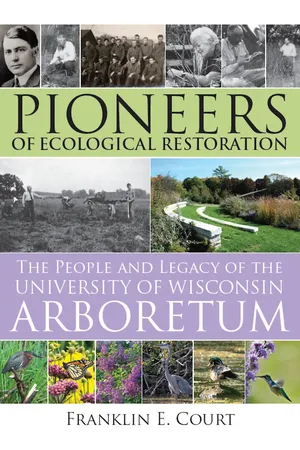
Pioneers of Ecological Restoration
The People and Legacy of the University of Wisconsin Arboretum
- 336 pages
- English
- PDF
- Only available on web
Pioneers of Ecological Restoration
The People and Legacy of the University of Wisconsin Arboretum
About This Book
Internationally renowned for its pioneering role in the ecological restoration of tallgrass prairies, savannas, forests, and wetlands, the University of Wisconsin Arboretum contains the world's oldest and most diverse restored ecological communities. A site for land restoration research, public environmental education, and enjoyment by nature lovers, the arboretum remains a vibrant treasure in the heart of Madison's urban environment.
Pioneers of Ecological Restoration chronicles the history of the arboretum and the people who created, shaped, and sustained it up to the present. Although the arboretum was established by the University of Wisconsin in 1932, author Franklin E. Court begins his history in 1910 with John Nolen, the famous landscape architect who was invited to create plans for the city of Madison, the university campus, and Wisconsin state parks. Drawing extensive details from archives and interviews, Court follows decades of collaborative work related to the arboretum's lands, including the early efforts of Madison philanthropists and businessmen Michael Olbrich, Paul E. Stark, and Joseph W. "Bud" Jackson.
With labor from the Civilian Conservation Corps during the 1930s Depression, University of Wisconsin scientists began establishing both a traditional horticultural collection of trees and plants and a completely new, visionary approach to recreate native ecosystems. Hundreds of dedicated scientists and staff have carried forward the arboretum's mission in the decades since, among them G. William Longenecker, Aldo Leopold, John T. Curtis, Rosemary Fleming, Virginia Kline, and William R. Jordan III.
This archival record of the arboretum's history provides rare insights into how the mission of healing and restoring the land gradually shaped the arboretum's future and its global reputation; how philosophical conflicts, campus politics, changing priorities, and the encroaching city have affected the arboretum over the decades; and how early aspirations (some still unrealized) have continued to motivate the work of this extraordinary institution.
Frequently asked questions
Information
Table of contents
- Contents
- List of Illustrations
- Preface
- Acknowledgments
- List of Abbreviations
- 1. The Beginnings: John Nolen, Michael Olbrich, Paul E. Stark, and the Prairie School of Landscape Design
- 2. 1930–1932: Acquiring the Land, Building the Road
- 3. 1932–1934: Pre-Dedication Years, Edward M. Gilbert, Aldo Leopold, G. William Longenecker, the Politics of Governance
- 4. 1934–1935: Two Directors, Dedication, Camp Madison, and the CCC
- 5. 1935: “Go Make a Prairie,” Fassett’s Planting Experiments, Sperry’s Fieldwork
- 6. Late 1930s: Frustrations, “Golden Years,” Efforts to Increase Funding
- 7. The 1940s: Curtis Years, Postwar Challenges, Leopold’s Death
- 8. The 1950s: Outside Threats, “the Beltline Cometh”
- 9. The 1960s: Last Lost City Lots, Building a Reputation, Shifting Focus
- 10. The 1970s: World Famous Prairies, Conflicts in Leadership, New Appointments and a Visitor Center
- 11. The 1980s and Beyond: A Restoration Ecology Legacy, “Earth Partnerships,” Reflections
- Notes
- Bibliography
- Index